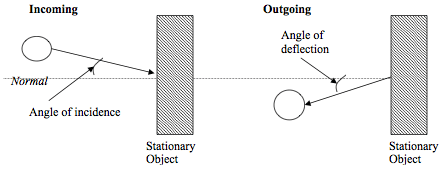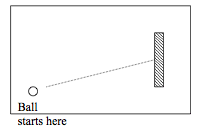Overview back to the top ↑
Make a prediction of where a ball will go after it bounces off an object.
Grades: 1-4 (National Standards)
Time: Approximately 45 minutes
Background back to the top ↑
Science is based upon observing natural phenomena. The motion of objects at the macroscopic (visible with the naked eye) scale is considered to be predictable. The laws of motion have been thoroughly tested and the theory initially developed by Isaac Newton in the 1600's has been repeatedly verified. One concept is angle of deflection, or how objects move after they bounce off something. Examples of this motion are seen all around us, such as: pool or billiards, a bounce pass in basketball, a header pass in soccer, or hitting a tennis ball or baseball.
An object on a flat surface will travel in a straight line until it encounters an obstacle, or in other words, hits something. If the object strikes a stationary or fixed object head on, it will bounce back along the same path it traveled.

If it hits the stationary object at an angle, it will not bounce back along the same path. The object will be deflected at an angle equal to the angle it hit the object at, but in the opposite direction. So, the angle of the incoming object (angle of incidence) is equal to the angle of outgoing object (angle of deflection). For example, if the angle of incidence is 45 degrees on one side of the normal line (imaginary line coming straight out of the stationary object), then the angle of deflection is 45 degrees on the other side of the normal line. So the incoming angle will be equal to the outgoing angle around the normal line. One can predict the outgoing path of an object.

Particle physicists can use this technique to trace the pathways of subatomic particles.
Objective back to the top ↑
Predict the path a ball will follow after it bounces off an object.
Materials back to the top ↑
Several students can work around a setup, but for each setup you need:
- Items that you can use as stationary objects including: round cake pan, flat surface made from a thick book, large cookie cutter shapes that can include stars and others. The objects have to be substantial enough so that they are not damaged when hit by the ball. You may need something to weight down the objects as well.
- A pencil
- A ruler and/or meter stick to help roll a ball in a straight line path and to draw incoming and predict outgoing paths
- Small rubber balls (1/2 inch to 1 inch in diameter) that roll easily and will bounce off objects with little damage.
- A large piece of paper (at least 12"x18") beneath the shape makes it easier for students to gather data as they can draw paths of incoming and outgoing balls
- Masking tape (to tape stationary objects down).
- Colored markers to trace paths of various trials
Procedure back to the top ↑
- Tape your first stationary object down on the far side of the paper as shown below.

- Start with a demonstration. Roll the ball and use a marker to illustrate the incoming and outgoing paths of the ball. You only need to draw the last 3-4 inches before the ball hits the stationary object and the first 3-4 inches after it hits and bounces off.
- Ask the students prepare their own setups. (As in Step 1)
- The students should decide on a path for rolling the ball and draw this incoming path in pencil on the paper (they can use a ruler to help).
- The students should now draw a line in pencil for their predicted outgoing path. (You could have the students draw a normal line to help them predict the angle of the outgoing path.)
- The students now roll their balls along the incoming path and use a colored marker to mark the actual outgoing path. Have them compare their predicted path with the actual outgoing path.
Question: How close is your predicted path to the observed path?
Question: How could you make your prediction more accurate? - Have the students select a different incoming path and repeat Steps 4-6 using a different colored marker for the new actual outgoing path.
Results and Discussion back to the top ↑
Ask the students how they predicted the pathway. For example, what information did they use? Did they become more accurate with their predictions with more trials? This can be used to discuss the scientific method such as replication and reliability of results as well as experimental design.
Follow up activities back to the top ↑
- Try the What shape is it? lesson plan. Here, students try to guess what a hidden shape is based on the paths of balls bounced against it.
- Play the Quarked Catcher game
National Standards back to the top ↑
This lesson plan addresses the following national standards in science and math:
Science
- Standard A – Science as Inquiry
Students should develop abilities necessary to do scientific inquiry and an understanding about scientific inquiry. - Standard B – Physical Science
Students should develop an understanding of the properties of objects and materials and the position and motion of objects. - Standard E – Science and Technology
Students should develop abilities of technological design. - Standard G – History and Nature of Science
Students should develop understanding of the nature of science.
Math
Understand patterns, relations, and functions
- Represent and analyze patterns and functions, using words, tables, and graphs
Apply appropriate techniques, tools, and formulas to determine measurements
- Use tools to measure
- Develop common referents for measures to make comparisons and estimates
- Select and use benchmarks to estimate measurements
Data Analysis and Probability Standard - Formulate questions that can be addressed with data and collect, organize, and display relevant data to answer them
- Formulate questions that can be addressed with data and collect, organize, and display relevant data to answer them
- Pose questions and gather data about themselves and their surroundings
- Sort and classify objects according to their attributes and organize data about the objects
- Represent data using concrete objects, pictures, and graphs
- Design investigations to address a question and consider how data-collection methods affect the nature of the data set
- Collect data using observations, surveys, and experiments
- Represent data using tables and graphs such as line plots, bar graphs, and line graphs
